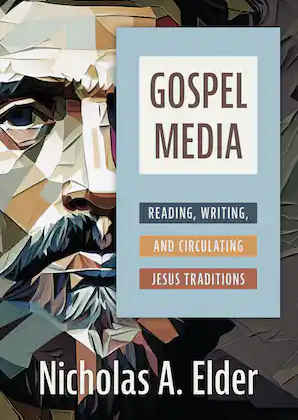

Today is book launch day for Nicholas Elder’s Gospel Media: Reading, Writing, and Circulating the Jesus Traditions (Eerdmans). Dr. Elder is assistant professor of New Testament at the University of Dubuque Theological Seminary. He is also the author of The Media Matrix of Early Jewish and Christian Narrative (T&T Clark, 2019). I am so grateful that he has taken the time to answer some questions about his new book and other work!
Congratulations on your book! I would love to hear a bit of a back story about this project: how does a New Testament scholar with a healthy love of ancient papyri write a book on Gospel media–and what do you mean by this? How did you arrive at this project?
Thank you! For a long time, I have been interested in how people in the ancient world read New Testament texts. There’s this whole field of biblical studies called performance criticism that explores how a book like the Gospel of Mark might have worked as “performance literature.” And Mark still works very well as a performance. Actors like Max McLean and performance scholars like Phil Ruge-Jones compellingly present Mark this way. But I suspected that not all of the gospels were experienced this way in the ancient world. I wanted to answer the question “What are the different ways that the gospels were experienced in antiquity?” And this is how the book began. It’s divided into three parts. The first part answers that question about reading. The next two parts answer similar questions for writing and publication: what are the different options for how the gospels were written? How were the gospels published?
Two related questions: for whom did you write this book, and what do you hope will be the main takeaways that they get from reading it?
I have a couple different audiences in mind for the book. First, it is an academic book. In that sense it is written for New Testament scholars. There are a number of “myths” about how people read, wrote, and published texts in the ancient world. We often present people in the ancient world as more simple than ourselves. New Testament scholars, and I include myself here, have often repeated these myths without looking at what the ancients actually say about how these things worked. I hope this book will help dispel these myths and help us to stop repeating such claims.
Second, it is written for students of the New Testament, whether or not they consider themselves scholars. The book engages New Testament scholarship, but I intended to write it in a way that is not too inaccessible to those who do not have degrees in biblical studies.
Third, it is written for anyone who is interested in the literature of the ancient world. The book of course engages the gospels, but it also explores reading, writing, and publication in ancient Jewish and Greco-Roman contexts. I hope that scholars of ancient Judaism and classicists find that it informs their fields of study as well.
Can you give us a taste of something surprising that you found in your work on this book?
I was surprised at just how similar people in the ancient world were to us. For example, when the rhetorician Quintilian gives advice about how children should learn to write, he says that they should practice on a board in which grooved letters have been cut. With a pen, students follow the grooves in the board, and this strengthens their hand. When I came across this advice, my eldest child was learning to write with just this method at his Montessori school, using metal insets. I went and read Dr. Maria Montessori’s handbook and found that much of what she had to say about practicing on insets matched Quintilian’s advice.
What are the broader questions that fascinate you in your reading, thinking, and writing?
I am interested in the lives and practices of people in the ancient world. This book engages how people read, wrote, and published texts. I am interested in how real people did these things in the ancient world. You mentioned earlier my healthy love of ancient papyri. I can spend hours poring over these documents—whether they be letters, receipts, or contracts—precisely because they offer a window into the lives of people from the ancient world.
It always seems overly aggressive to ask someone who just published a book: what’s next? But I’m asking in my most encouraging and friendly tone here: what’s next for you?
I plan to turn my attention to the apostle Paul and ask similar questions about his reading, writing, and circulation practices as those engaged in this book with respect to the gospels. My suspicion is that much of Paul’s work of establishing churches across the Roman empire involved practical skills of reading and writing and that these make their way into his letters. For example, Paul probably had to know how to draft certain kinds of financial documents, such as a cheirograph, which is essentially a receipt. Colossians 2:14 mentions this kind of text, stating that “God crossed out the cheirograph that stood against us.” I want to explore how understanding elements of business literacy, like cheirographs, can inform how we understand Paul.